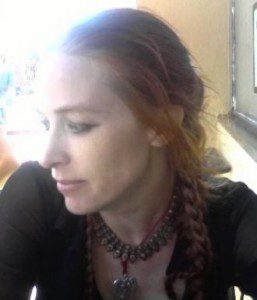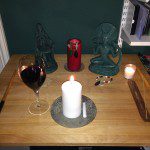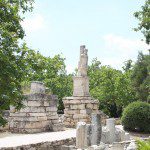Morpheus Ravenna is a priest, spirit worker, artist, and initiate of the Anderson Feri tradition of Witchcraft. Her primary spiritual practice is her dedication to the Morrígan, a devotional practice of about twenty years. Her interests include folk magical traditions, devotional art, and Celtic heroic spirituality. She writes the Shieldmaiden Blog and she is known in her community for her service as a priest of the Morrígan, in addition to spearheading the Coru Cathubodua Priesthood. She can be reached through her website at http://bansheearts.com/.
Morpheus is fundraising to publish The Book of the Great Queen, a book that’s long been needed, exploring the mysteries of the Morrígan, the ancient Celtic Goddess of battle, sovereignty, prophecy, and Otherworld power, combining the depth of historical perspective with the insights of a modern practicing devotional polytheist.
The fundraising page, with details, pictures, and backer rewards can be found at http://bookofthegreatqueen.com/
John: What was your religious life like growing up? Looking back, were there any hints that you’d end up doing what you’re doing?
Morpheus Ravenna: I was raised by an agnostic father with a love for nature and transcendentalist philosophy, and a highly religious mother who practices a tradition based in Hinduism. I learned meditation and yogic practices fairly young, and my first religious experiences were with Indian deities such as Krishna and Durga. We would go to devotional services where chanting, meditation, and offerings were given as devotion. I think that having an awareness from a young age of the concept of bhakti and what it means to be in a devotional relationship with deities certainly affected my growth into Pagan practice. When I began to discover my instincts for witchcraft and to experiment with Pagan practice as a teenager, my early experiences there were very ecstatic, and that focus on devotional communion is what drew me to the Feri tradition as well.
You’re a Feri initiate – how did your Feri training help you prepare for your work as a priest?
Feri itself is priest training – at least the way it is practiced in my lineage. It’s understood that direct devotional relationship is the core of the practice and that every initiate becomes a priest, in the sense of priesthood as service to the Gods. The coven I was trained in provided this very intimate, safe container in which I was able to learn the practices of devotion, invocation, and possession. Those things have been key to my work as a priest of the Morrígan.
When did you first meet the Morrígan? What was your initial impression of Her?
I was introduced to Her in ritual with my teachers in the Feri coven, around the age of 18 or 19. My early feeling for Her was one of awe, and a sort of indescribable mix of beauty and terror, like falling in love. I think She impacted me so much partly because Her presence was just so strong – I remember feeling like maybe I’d never met a God before, because Her presence was ovewhelming and put all the other experiences I’d had with deities into the shade. There was also a profound feeling of recognition.
When did you realize you were going to be more than an casual devotee of Her? How did you respond to that realization?
The coven had a regular and established devotional relationship with Her, and it was part of my work in the coven to do those devotions and to study Her. So it wasn’t really a choice for me – or rather, it was inherently part of my choice to work within that lineage.
I actually had a hard time with it at first. At the time, I had very pacifistic ideals and was against the idea of war and violence. I didn’t see anything of value in them. So as I began to study Her and learned about Her associations with battle and carnage and violence, I was actually really disturbed by that and had kind of this moral crisis where I was asking myself “What am I worshiping? Am I perpetuating something terrible by worshiping this deity?”
I had to go into a series of deep dialogues with Her in my devotions, questioning and exploring this conflict. I asked Her to help me understand. And She did. Those dialogues really shaped who I’ve become.
You were featured in the documentary film American Mystic. What impact has that film had on your spiritual life and religious work?
Working on the film was this big leap of faith for us. We didn’t let her film much in ritual, but our life outside of that was pretty much an open book. It could have been a big disaster if she’d been seeking to put some kind of slant on our story. It ends up being a lesson in trusting your instincts, because the film turned out to be beautiful and honest and I feel like it really does capture a picture of what life was like at Stone City, and Alex and I are good friends now and continuing to collaborate.
And of course, it’s a snapshot, and almost everything in my life has changed since that time. I’m no longer in that marriage or living at Stone City. I’m glad I did that film, but I often hope people realize that it only reflects a particular moment in my life that’s now six years ago.
What are your most helpful spiritual practices? What do you do that keeps you grounded and keeps you doing the work you’re called to do day in and day out?
Daily meditation and offerings are the core of my practice. I do simple offerings to the Morrígan, and an inner practice that is partly based on Feri soul alignment, and partly inspired by the Druidic “three cauldrons” lore, and I meditate. When I’m in the flow of that practice and really doing it daily is when I can hear my spiritual guidance most clearly. It is really critical when you are in any kind of public leadership position to be solid in your spiritual practice. That’s a daily opportunity for course correction, for fresh insight, and it also renews your energy to be able to keep doing the work.
I also practice a martial art as part of my devotions, because it’s something She requires of me. So I keep myself in physical shape and I get in armor and fight. I also have a commitment to deeper devotional work on a regular basis, monthly and seasonally.
How do you see priesthood, particularly as it’s expressed in your role as Priest of the Morrígan?
I think priesthood is more than just devotion to a deity. As a priest, your devotional practice must serve someone other than just yourself. If your devotional practice is primarily about deepening your own personal connection, and/or getting personal guidance from the deity for your own path, that’s not priesthood. That’s just being a devotee. Priesthood means your devotional practice is serving the needs and agenda of the deity, and of the community of devotees. It is fundamentally a service role. If you can’t clearly identify who benefits from your practice and how, then it’s not priesthood.
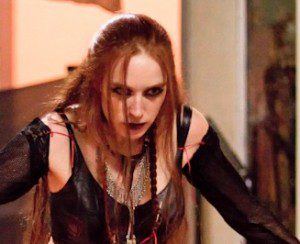 You founded the Coru Cathubodua as a Priesthood of the Morrígan. What have you been able to do in a dedicated priesthood that you couldn’t have done individually or by working informally with others?
You founded the Coru Cathubodua as a Priesthood of the Morrígan. What have you been able to do in a dedicated priesthood that you couldn’t have done individually or by working informally with others?
Founding the Priesthood has enabled a number of important things: for one, it provides a cadre of people to share the work of responding to the many, many emails asking for help and guidance in working with the Morrígan. Having a cadre of priests who share a common dedication to devotional practice and honing of skills also provides a stronger lens within which any one priest’s insights and guidance can be checked, clarified and amplified by the insights and guidance that others are receiving. That’s incredibly valuable to me. It has allowed us to gain a much clearer sense of what the Morrígan wants from Her dedicants, where She is moving, how She wants us to respond to the times we are living in.
The Coru Priesthood is part of a phenomenon of dedicated priesthoods starting to reappear – something we have seen little of since ancient times, and that I think is a really important development in modern Paganism. It represents a developing peer group, a collegiate culture which I think will raise the bar for modern priesthood and benefit everyone. Sam Webster has written some about this in his blog, and he’s been a very supportive peer and mentor for me and for the Coru Priesthood.
You aren’t a professional academic, but you do a considerable amount of scholarly research. What complications have you run into as an independent scholar? What advantages do you have over a professional academic?
The scholarship aspect of my work has certainly had its challenges. I’ve run up against the limitation of access to academic materials. Some of this can be overcome with help from friends who work at universities; some of it can be dealt with by just paying for subscription access and rare books. The campaign will hopefully help with that.
Another part of it is just the time investment. I’m not a professional academic – I’m an independent artist subsisting on three different jobs, so the time commitment has been hard. But I’m nearly done with the research, so the project is picking up its own speed, and the campaign will also help by funding the dedicated time I need to finish the project.
I do have the advantage of being a lifelong nerd. I’ve always been the kind of reader who keeps one finger in the end-notes pages, and looks at all the references. While I don’t have a degree in Celtic studies, I did get a University of California education and it taught me how to read critically, how to check sources and evaluate arguments, and how to use academic research tools. And I’ve been soaking my head in my topic for years before I made the commitment to write the book.
I also think that as a ritualist I bring something extra to the research that is not as often seen in academia. I can look at a text and see the veiled references to ritual, and as someone who isn’t writing for academia, I can stick my neck out a little more – I can gather these clues and work with them in a more experiential way. I like to be really clear about the difference between intuitive and research-based information, but I definitely make use of both.
How do you balance historical research with personal gnosis in your practice?
In my personal practice, it’s a synthesis of both. I’m kind of voracious about studying ancient cultures, but my practice is very much inspired by my personal relationship with the Gods and by what comes alive for me. What comes alive for me tends to be elements of ritual that hearken to something ancient, but in the process of coming alive in my own modern practice, I recognize that there are ways we are changing them fundamentally. I also think that since we have virtually zero first-hand information about Celtic religious practice, the idea of reviving or reconstructing an ancient practice is very iffy to me.
Are there elements of ancient practice that are irreconcilable for me? Sure… like the Celtic cult of the head. I’m not likely to be drinking from the skull of an adversary, or displaying severed heads on the gates of my temple. Other offerings make more sense for us now.
Another example of a conflict is funerary ritual. Excarnation (exposure of the body to carrion birds) is a rite I’m drawn to, both based on historical tradition and my own feelings, but it’s illegal almost everywhere.
What made you realize you needed to write a book on the Morrígan? What made you decide – or agree – to do it?
I have been doing the research on the Morrígan and Celtic traditions for years just to better inform my own practice and the people I work closely with. At some point I had this realization that there’s a huge divide between the quality of information that exists in academic-type sources, and the quality of information that’s been presented to Pagans in popular literature on the subject – most of which is written from a Wiccan viewpoint. One of the most common questions I get is “What book should I read to learn about the Morrígan?” When I realized that the book I really wanted to recommend to them didn’t exist yet, I recognized that I was going to have to write it.
I decided to take it on a year or two ago, and was kind of gradually picking away at it in my spare time. Then this March the Morrígan grabbed me during devotional practice and laid a nóinden on me to get it done by the end of the year. So at that point there really was no question.
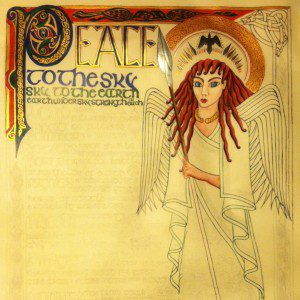 Tell us a little about what the book is going to be.
Tell us a little about what the book is going to be.
My intention for the book is to bridge the gap between what scholars know of Her and what modern Pagans have had access to. So I hope to bring forth the depth of the scholarly perspective, in a way that’s accessible and inspiring and of use to modern practitioners.
I’m including an in-depth examination of Her various names, epiphanies, and aspects; the major relationships and stories in which She acts, and a whole chapter on Her own poetry and what She tells us in Her own words. I’m looking at what we can glean from ancient Celtic religion that sheds light on how She was understood and worshipped; information about sacrifice, seasonal rites, oracular and divinatory practices; weapon and warrior cultus; sorcery and magical practice; relationship to Druidic priesthood and sovereignty systems; land veneration and sacred sites; and lots more.
And then I’ll be sharing insights about how modern practitioners can develop a devotional practice with Her, both informed by the past and inspired by who She is today.
Who are you writing for? How do you hope they’ll use the book?
I’m writing for anyone who is interested in the Morrígan, be they Pagans or just interested in Celtic traditions. I think that the people who will benefit most from my work are Pagans and polytheists of various sorts. Some people will benefit from the scholarship aspect of it, maybe bringing them a deeper knowledge than they had before of where She comes from. Others who might already have a lot of scholarship under their belt may benefit more from the devotional practice aspect of the book, where I can bring them something from my experience as a ritualist and priest that can help deepen their practice.
Talk about the process by which this book is becoming a reality.
Right now I’m finishing the research component and shifting my attention more fully into writing the text. Since I got my “marching orders” earlier this year, I’ve been dedicating a certain number of hours each week to working on the book – but to finish it on time for the timeline She set me and for my publication schedule with Concrescent Press, I need to increase the time I can dedicate each week. So the IndieGoGo campaign is about funding that – it will allow me to quit one of my part-time jobs and dedicate that additional time to writing, and it will cover up-front publication costs to go from manuscript to print.
I chose Concrescent Press because it offers me a lot of autonomy as an author, and because I really like supporting independent publishing and arts ventures. And I figured it would be hard for me to compete for attention from any of the big publishing houses. Concrescent really respects its authors and I want to support that, even if it means that I have a smaller marketing engine behind my work.
What are some of the rewards you’re offering to people who support this project?
The core thing, of course, is the book itself, and people can basically pre-order their copy of the book through the campaign. We will have e-book versions as well as signed print versions. And then for the true book fetishists, we are going to have a limited number of beautiful hand-bound artistic editions, which will be made by Amelia Hogan, who is a book artist and also a priest of the Morrígan in her own right.
Apart from the book-based rewards, I figured that the best gift I can bring to the table is my artwork. So I’m creating a gorgeous, highly detailed new devotional art piece, an illuminated manuscript style painting on vellum of the Morrígan with Her “Peace to the Sky” prophecy poem, and we’re creating perks out of that: prints, t-shirts based on the design, etc. And I’ll also be offering the original as a high-level reward for that one person out there who can maybe afford it. It’s still in progress and I’ve been updating followers with new photos as I carry the painting from one stage to the next. I’m pretty excited about this art.
How long will the crowdfunding campaign run?
It’s a 36-day campaign, so with our launch on June 10th, it will be wrapping up July 15th.
When will the book be available?
I’m due to deliver my manuscript to Sam of Concrescent Press on December 31st of this year. Then it’ll be for editing and layout, and we should see publication in mid- to late spring of next year.
Anything else you’d like to tell our readers?
One of the reasons I’m excited about the crowdfunding process is that it will involve people in creating the book. So as part of the backer rewards, people will get to participate with me and I’ll be staying in touch with them, hosting online chat sessions, asking for feedback, etc. I’m really interested in knowing what questions people have about the Morrígan that I can help answer in this book. And generally, I love that the project can bring together a broader community of people who share an interest in Herself and Her history. That’s a big part of what this journey is about for me.
Morpheus, thanks so much for the interview. Good luck with the book!


